A yellowed dog carcass hanging on the world’s longest fence adds a curt footnote to the sign that warns you can be fined $1000 if you don’t shut the gate. They are pretty serious about trying to control wild dogs in this part of the world.
Cameron Corner, that iconic outback post where the corner of NSW and Queensland abut South Australia, is about half way along the 5614km of the Dingo Fence and is a hell of a lot better place to live than flashy Port Douglas, say Fenn and Cheryl Miller.
They left their home in Port Douglas when the ritzy crowd moved in and headed west to find the real Australia again. Port Douglas grew in popularity with the glamour crowd after Christopher Skase built a Mirage resort there.
“We didn’t like the way it changed,” said Fenn. “Too flashy. No sense of community anymore. Everyone started getting greedy.”
After a spell up in the Kimberley they bought the Cameron Corner Store six years ago and get to celebrate New Year’s Eve three times a year.
“We stand around the post and start in the NSW corner,” says Cheryl as Tony and I settled in at the bar for what proved an enjoyable afternoon stretching well into the evening. “Half an hour later it’s midnight in South Australia and half an hour after that in Queensland.”
Queensland is not on daylight saving so it’s last.
She and Fenn love their life, even though it has its challenges and long hours. Days start at 7.30am and can end about 1.30pm to cater for the thousands of people each year passing through the dusty roads to and from three states. Some come on postie bikes, tractors or ride-on mowers. A shearer came from NSW pushing a shopping trolley. A French couple walked by to follow the footsteps of Burke and Wills 150 years after that ill-fated expedition.
A miner barrelled through on a motorbike to set the record for crossing Australia at the east and west extremities of the mainland. He went from Steep Point to Byron Bay in three and a quarter days, made all the more impressive because he first rode 500km to the start at Steep Point.
“We’ve got a mountain bike rally coming through in May,” said Fenn. “Some nights during the season the whole camping area on the hill is lit up, the caravan park is full and all our accommodation units are full. The next night we might have two people staying here.”
Fenn has worked in the building trade and Cheryl’s background is mainly hospitality. They both try to keep the spirit of outback hospitality alive but Fenn’s patience gets tested when the city boys roar in in a cloud of dust. “Sometimes I meet them at the door with a broom and tell them they caused it (the drifted-in dust) and they can sweep it up.”
The Corner Store sits in the Sunshine State corner. Fenn and Cheryl like that. It means they are still Queenslanders, even if just by a few metres.
It’s a bit mixed up, authority wise. They come under the South Australian Regional Tourism Authority and NSW controls the dog fence. They have a NSW postal code and a South Australian phone number.
“I’ve had two phone calls from Google asking where we are,” said Cheryl. Saying “halfway along the longest fence in the world” doesn’t quite answer the question.
The Dingo Fence started out in the 1880s as a futile attempt to control the rabbit plague with a series of fences. They fell into disrepair until 1914 when they were repaired to keep dingoes from sheep stations. In the 1940s the fences were joined together to form a continuous 8614km line, shortened by 3000km in 1980.
It is maintained by the NSW Wild Dog Destruction Board, which employs boundary riders, each responsible for up to 60km of the fence.
Fenn and Cheryl’s busiest year at the Corner Store was 2009 when Lake Eyre filled up and word went out it was a once in a lifetime opportunity to see the lake with water in it. It wasn’t – it still has water – but throngs of Australians headed inland.
That year Cameron Corner nearly ran out of water. “We had three weeks of drinking water left in November then the heavens opened up,” said Cheryl.
“We had 11 years’ worth of rain in two months. It was beautiful. Baby ducks came out and were walking on the veranda. Birds’ eggs were everywhere – if you left the car windows down they would be building nests in it.
“Larry from the Dog Fence left his washing on the line and the finches had nests in the pockets and in the rolled up sleeves. So then we had the mice plague. We were catching 300 a night.”
As the afternoon faded, Ken Ogilvie and his son Andrew rolled up from nearby Lindon Station. Their 3000 Herefords on a million-plus hectares are certified organic.
So are quite a few of the big cattle stations of the inland. It’s always been that way – no chemicals or pollutants. “We really just had to do the paper work,” said Andrew.
Mustering is a bit different from the old days though. Andrew uses a gyrocopter to find the cattle a radio down to the ringers on bikes.
Ken and Andrew had arrived with shovels. They pitched in with Fenn to dig holes and mix concrete, putting up posts for a broad sign that will be going up to announce a celebration for the 25th anniversary of the Cameron Corner Store at the end of May.
It’s going to be a decent affair. Andrew is keen to organise a bit of a sports day, with horse events and outback challenges. He wouldn’t mind if it became an annual event.
It’s going to be a bit of a hike back, but we wouldn’t mind if we swung back that way again to see how the inaugural event pans out.
Cameron Corner, that iconic outback post where the corner of NSW and Queensland abut South Australia, is about half way along the 5614km of the Dingo Fence and is a hell of a lot better place to live than flashy Port Douglas, say Fenn and Cheryl Miller.
They left their home in Port Douglas when the ritzy crowd moved in and headed west to find the real Australia again. Port Douglas grew in popularity with the glamour crowd after Christopher Skase built a Mirage resort there.
“We didn’t like the way it changed,” said Fenn. “Too flashy. No sense of community anymore. Everyone started getting greedy.”
After a spell up in the Kimberley they bought the Cameron Corner Store six years ago and get to celebrate New Year’s Eve three times a year.
“We stand around the post and start in the NSW corner,” says Cheryl as Tony and I settled in at the bar for what proved an enjoyable afternoon stretching well into the evening. “Half an hour later it’s midnight in South Australia and half an hour after that in Queensland.”
Queensland is not on daylight saving so it’s last.
She and Fenn love their life, even though it has its challenges and long hours. Days start at 7.30am and can end about 1.30pm to cater for the thousands of people each year passing through the dusty roads to and from three states. Some come on postie bikes, tractors or ride-on mowers. A shearer came from NSW pushing a shopping trolley. A French couple walked by to follow the footsteps of Burke and Wills 150 years after that ill-fated expedition.
A miner barrelled through on a motorbike to set the record for crossing Australia at the east and west extremities of the mainland. He went from Steep Point to Byron Bay in three and a quarter days, made all the more impressive because he first rode 500km to the start at Steep Point.
“We’ve got a mountain bike rally coming through in May,” said Fenn. “Some nights during the season the whole camping area on the hill is lit up, the caravan park is full and all our accommodation units are full. The next night we might have two people staying here.”
Fenn has worked in the building trade and Cheryl’s background is mainly hospitality. They both try to keep the spirit of outback hospitality alive but Fenn’s patience gets tested when the city boys roar in in a cloud of dust. “Sometimes I meet them at the door with a broom and tell them they caused it (the drifted-in dust) and they can sweep it up.”
The Corner Store sits in the Sunshine State corner. Fenn and Cheryl like that. It means they are still Queenslanders, even if just by a few metres.
It’s a bit mixed up, authority wise. They come under the South Australian Regional Tourism Authority and NSW controls the dog fence. They have a NSW postal code and a South Australian phone number.
“I’ve had two phone calls from Google asking where we are,” said Cheryl. Saying “halfway along the longest fence in the world” doesn’t quite answer the question.
The Dingo Fence started out in the 1880s as a futile attempt to control the rabbit plague with a series of fences. They fell into disrepair until 1914 when they were repaired to keep dingoes from sheep stations. In the 1940s the fences were joined together to form a continuous 8614km line, shortened by 3000km in 1980.
It is maintained by the NSW Wild Dog Destruction Board, which employs boundary riders, each responsible for up to 60km of the fence.
Fenn and Cheryl’s busiest year at the Corner Store was 2009 when Lake Eyre filled up and word went out it was a once in a lifetime opportunity to see the lake with water in it. It wasn’t – it still has water – but throngs of Australians headed inland.
That year Cameron Corner nearly ran out of water. “We had three weeks of drinking water left in November then the heavens opened up,” said Cheryl.
“We had 11 years’ worth of rain in two months. It was beautiful. Baby ducks came out and were walking on the veranda. Birds’ eggs were everywhere – if you left the car windows down they would be building nests in it.
“Larry from the Dog Fence left his washing on the line and the finches had nests in the pockets and in the rolled up sleeves. So then we had the mice plague. We were catching 300 a night.”
As the afternoon faded, Ken Ogilvie and his son Andrew rolled up from nearby Lindon Station. Their 3000 Herefords on a million-plus hectares are certified organic.
So are quite a few of the big cattle stations of the inland. It’s always been that way – no chemicals or pollutants. “We really just had to do the paper work,” said Andrew.
Mustering is a bit different from the old days though. Andrew uses a gyrocopter to find the cattle a radio down to the ringers on bikes.
Ken and Andrew had arrived with shovels. They pitched in with Fenn to dig holes and mix concrete, putting up posts for a broad sign that will be going up to announce a celebration for the 25th anniversary of the Cameron Corner Store at the end of May.
It’s going to be a decent affair. Andrew is keen to organise a bit of a sports day, with horse events and outback challenges. He wouldn’t mind if it became an annual event.
It’s going to be a bit of a hike back, but we wouldn’t mind if we swung back that way again to see how the inaugural event pans out.
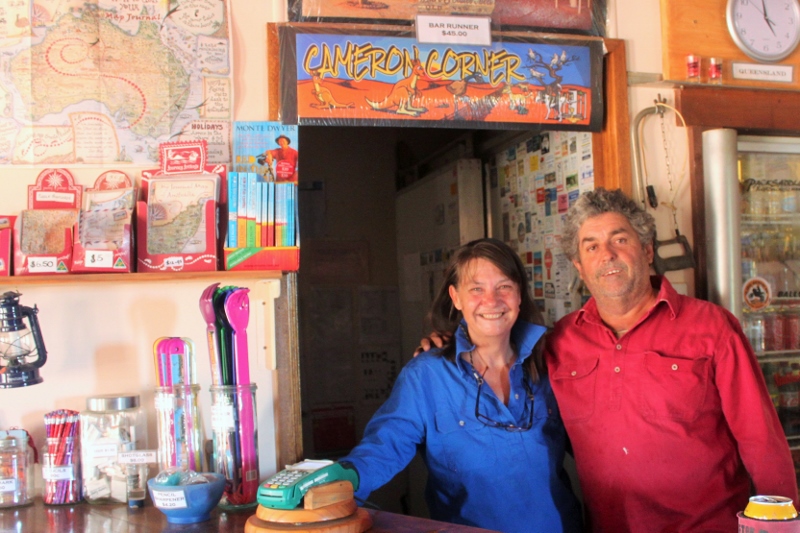
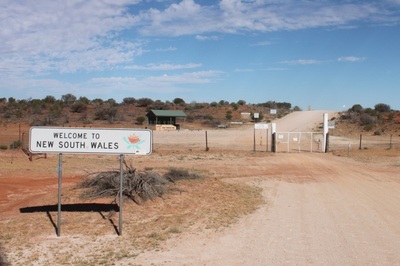

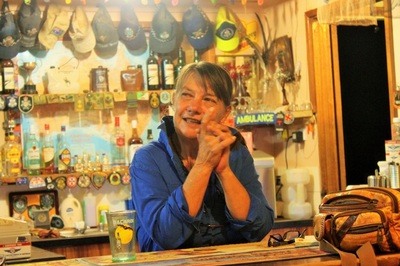
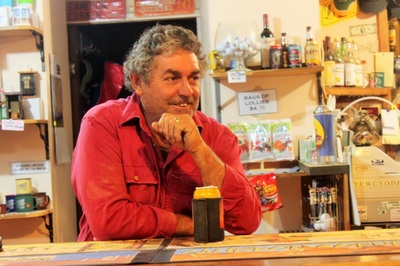
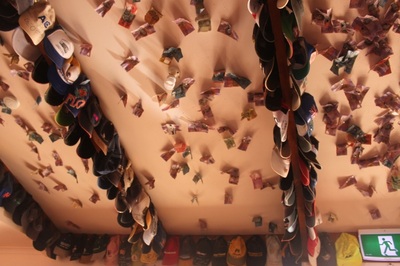
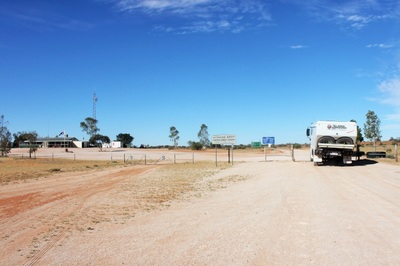
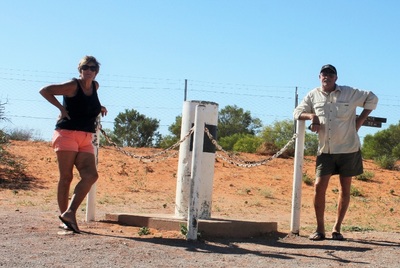
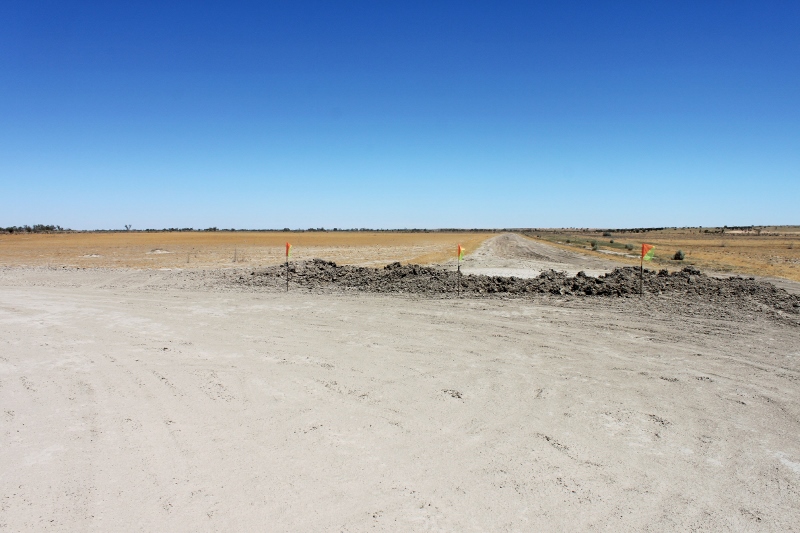
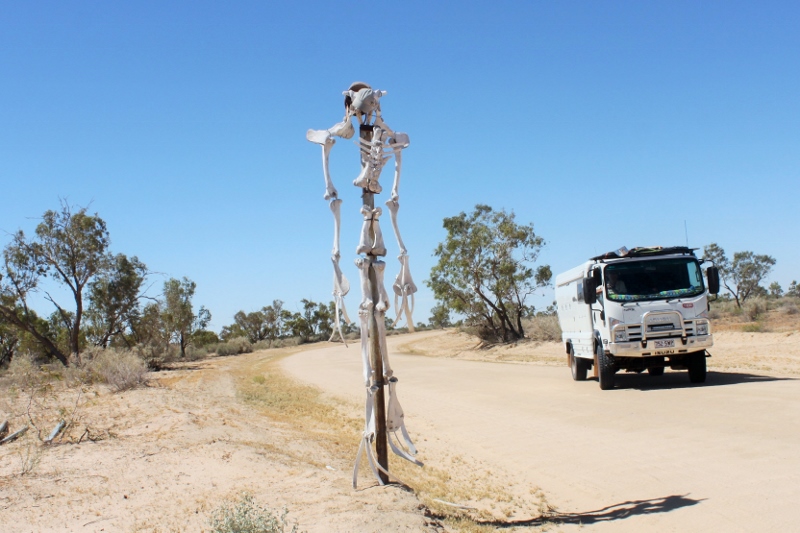

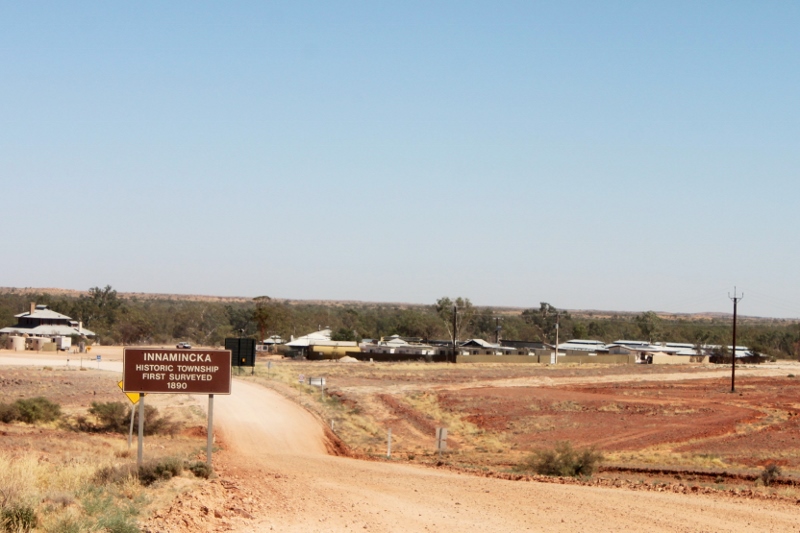
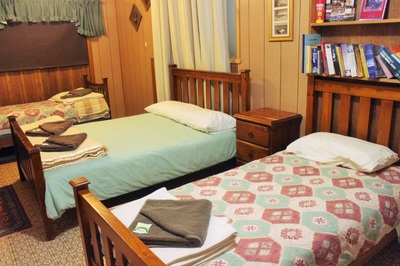
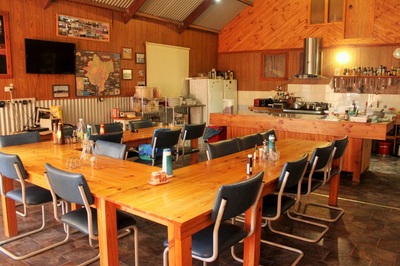
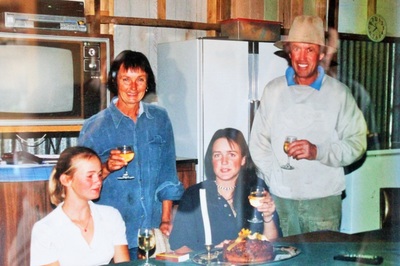
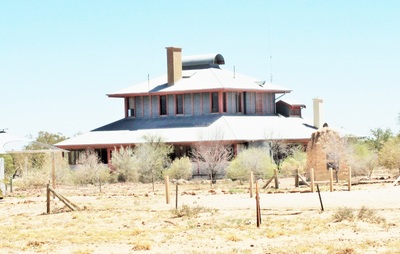
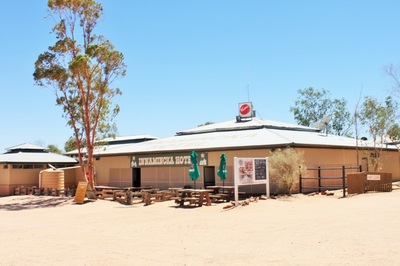
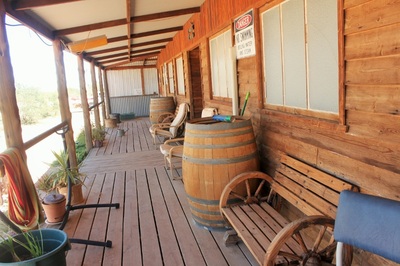
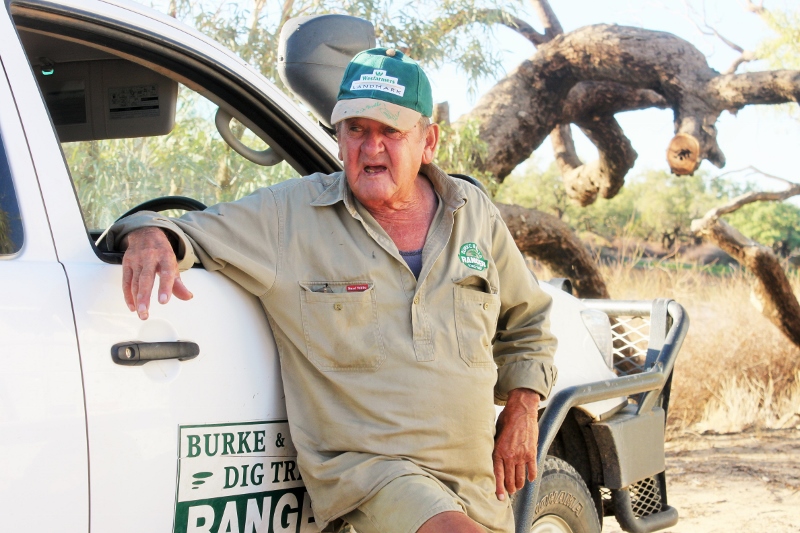

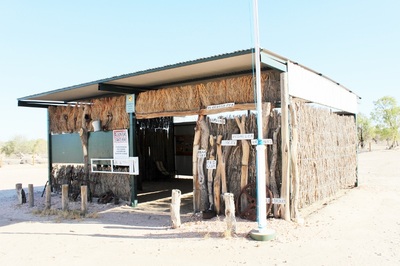
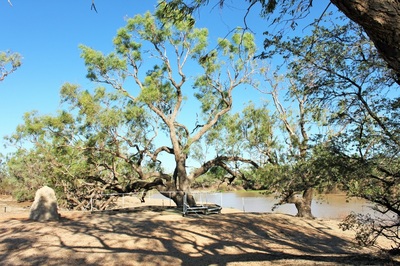
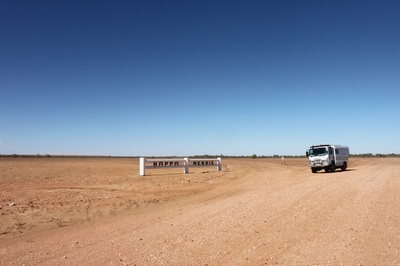
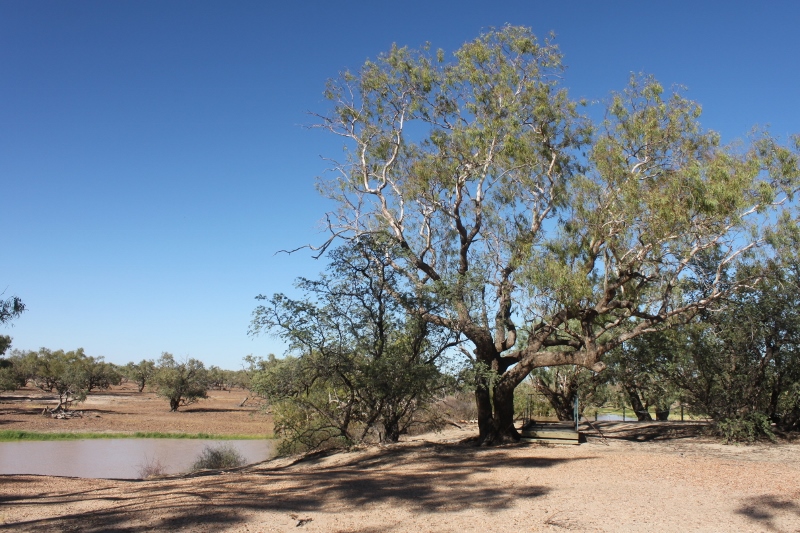
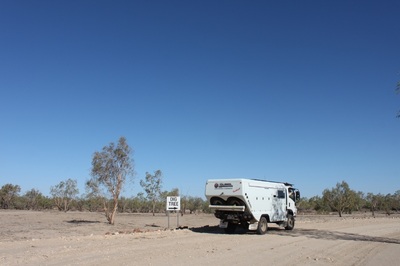
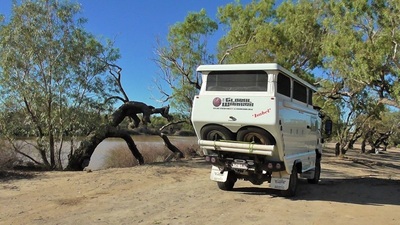
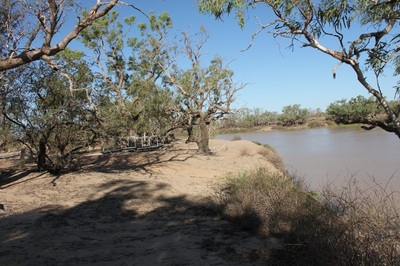
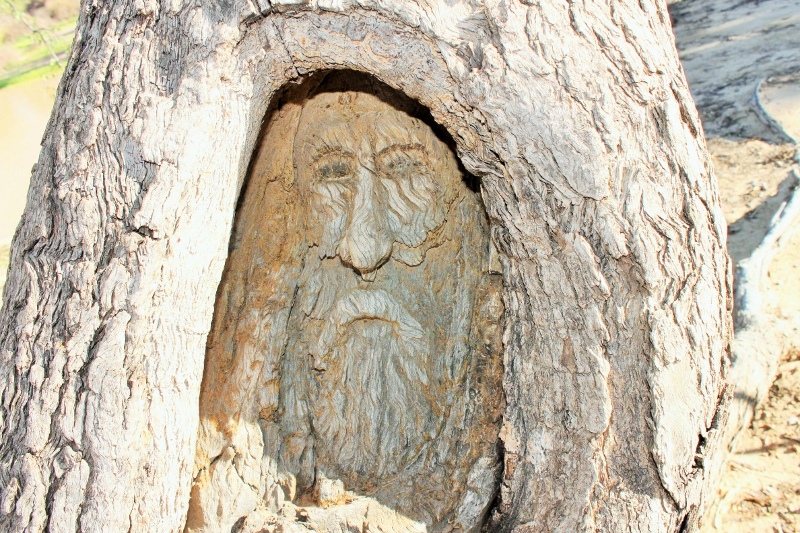
 RSS Feed
RSS Feed
